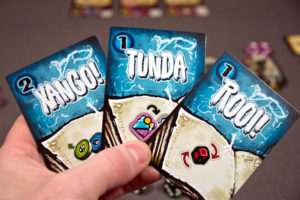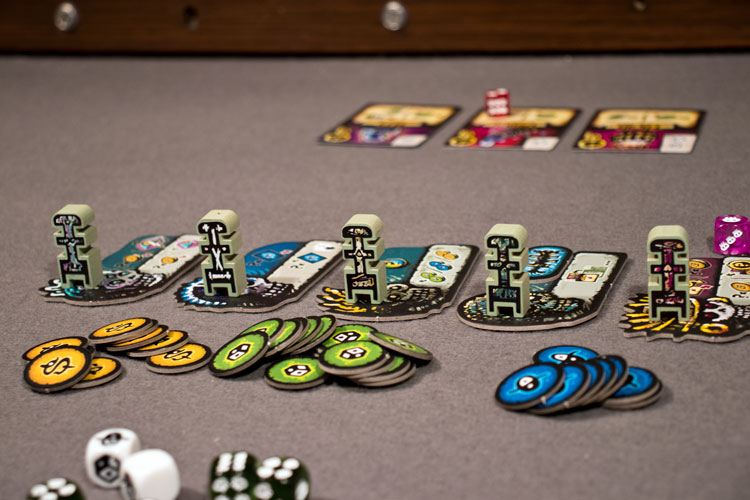 One of my surprise hits of 2014 was the dice rolling game Ancient Terrible Things. You can check out the full review for my thoughts on the game, but I cheekily dubbed it as “What Yahtzee would be if Yahtzee were fun”.
One of my surprise hits of 2014 was the dice rolling game Ancient Terrible Things. You can check out the full review for my thoughts on the game, but I cheekily dubbed it as “What Yahtzee would be if Yahtzee were fun”.
Game designer Simon McGregor has decided to take another stab at the genre, this time in a 2 player only game called Konja. Yet this time, instead of being intrepid jungle explorers, players are rival shamans trying to bring storms to the parched land.
Konja is a 2 player dice rolling game that takes about 30 minutes to play.
Gameplay Overview:
The goal in Konja is to be the first player to reach 21 points. Each turn is played out over three phases:

Ancestor: The active shaman places an idol on an available ancestor tile. The player then receives a favor from that tile. Then, both shamans receive the blessing from that tile. Blessings are bonus actions that consist of gaining resources, relics, spells and victory points. The favors are usually a more powerful bonus tacked on to the matching blessing action.
Bones: The active wizard rolls 5 green dice and 2 action dice. They may then uses spells and Artifact cards to try and manipulate the results. Spells must be paid for with resource tokens, while artifacts are “exhausted” or require an action die to activate. The player is aiming for sets, runs, and high numbers on their dice roll.
Collection: In the collection phase, your opponent will have a chance to attack your results using a red die. Afterwards, the active wizard will exchange their dice results to gain resource tokens or victory points, depending on their results.
Afterwards, the next player takes their turn. Play continues until one player hits 21 points and summons the great storm.

Game Experience:
If you’ve played McGregor’s first game, Ancient Terrible Things, then the artwork might look familiar to you. Publisher Pleasant Company Games smartly brought back artist Rob van Zyl to do the artwork and that was an excellent choice. He has a unique style that works well with the game and I hope to see him work on more titles in the future.

However when it comes to the gameplay, Konja is a bit of a mixed bag. It suffers from the problem of not really knowing what type of game it wants to be. I’ve played it quite a few times already, with each time trying to use a different strategy. The problem lies in the “take that” nature of the game.
Konja is a duel between two shamans, and there are ways to mess with your opponent (of course). However those ways are fairly limited. You have a red die that you will be able to use maybe once every 3 turns or so. Outside of that, there are a couple of spell cards. That’s really too limiting when you are trying to slow down your opponents. You are more of a speed bump then a hurdle for them.

However, you can also play Konja just fine without hurting your opponent. There is even a variant rule that makes the red die usable on your turn instead of as an attack die. The problem is that the game just isn’t very much fun in the passive state. It gets repetitive and is very luck based. You roll, maybe use an artifact or spell, and then collect your tokens. Rinse and repeat. Without the attacking, I found that I’d rather just play Ancient Terrible Things.
If you can get past its identity crisis, Konja does have some good mechanics. I enjoyed the favor selection, as it gave players a reason to stay invested when it wasn’t their turn. It can also create some tactical decisions as I’d try and grab a blessing that’s not only useful to me, but less so for my opponent.
Final Thoughts:
Konja feels like a game that was almost there. I wish they would have either doubled down on the attacking and fighting, or just pulled back all together. Where Konja stands now, it’s hanging out in a middle ground that’s not very satisfying for either camp.
If you can get past that though, it’s a solid game that does have its entertaining moments. There are plenty to do on your turn, and I enjoyed building up ways to manipulate the dice with spells and artifacts. Perhaps a future expansion could bring Konja where it needs to be.
Final Score: 3 Stars – A game that had a lot of potential, but ultimately seems to suffer from an identity crisis.
 Hits:
Hits:
• Great artwork
• Favor selection keeps players invested
Misses:
• Hangs out in the middle ground too much
• Can get repetitive without the conflict























